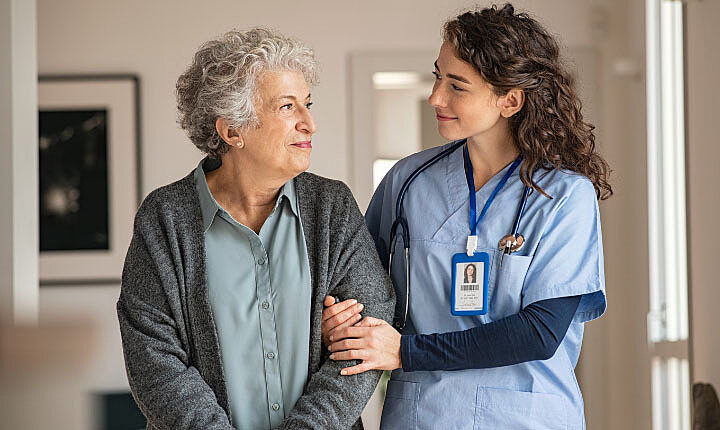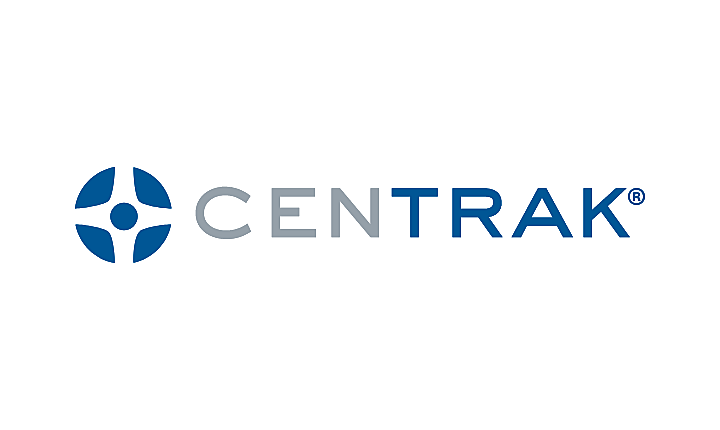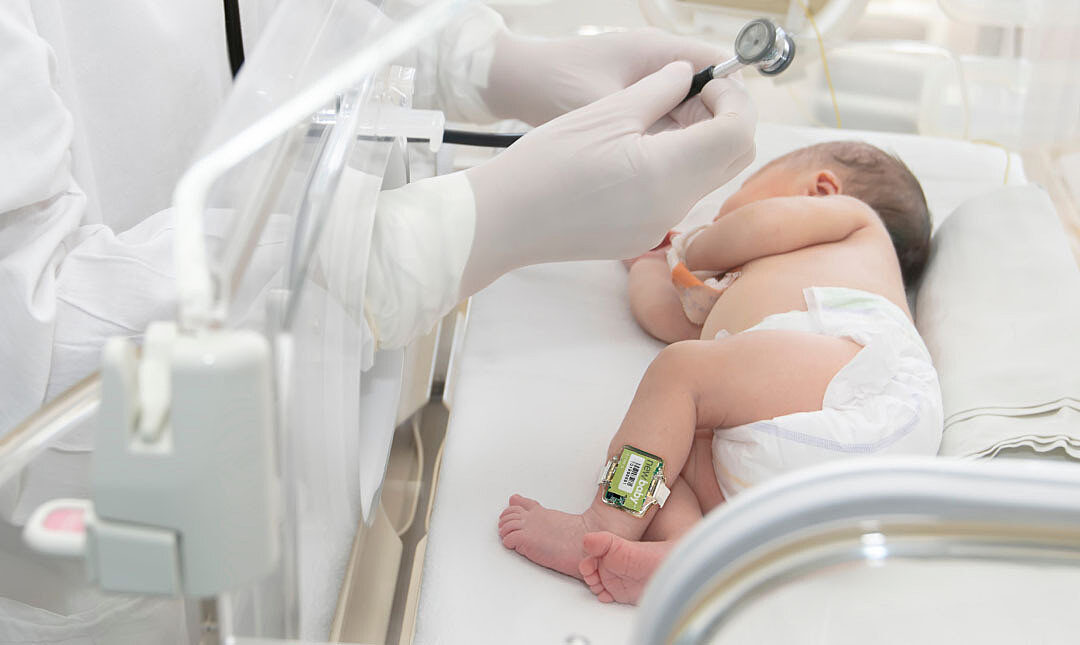15 Questions Your Hospital Staff Is Asking That RTLS Tech Answers
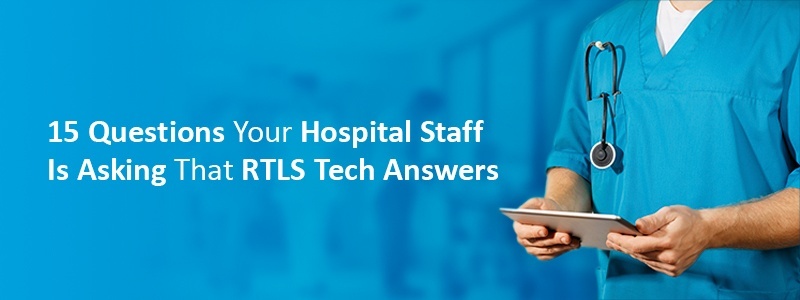
What if there was a simple way to improve your hospital's patient care, streamline its clinical processes and boost its overall efficiency?
With real-time location systems, or RTLS, creating a streamlined and efficient clinical care system can be a reality. This article explores specific ways each hospital staff member can take advantage of RTLS benefits.
How Does Real-Time Location Technology Work?
RTLS is a location-based service that uses several technologies, such as active radio frequency identification (RFID), low-frequency RF, second-generation infrared and Bluetooth low energy, to offer a highly accurate indoor locating system.
RLTS allows staff to identify the location of people and objects using radio waves sent by a specialized RFID reader that emits a signal to communicate location. The wearable sensor communicates with the RTLS to provide the real-time location of the person or asset wearing the sensor. This solution, with the correct hardware and software, is simple to achieve and can be combined with existing Wi-Fi systems.
CenTrak is reinventing the standard of healthcare delivery with our RTLS technology.
Once installed, RTLS can help a healthcare facility operate more efficiently by automatically informing staff of the exact location of patients, equipment and more. True workflow automation frees up limited time and allows staff to spend more time with patients, decrease wait time, provide more attentive care and reduce waste in general.
Keep reading to find out specific, everyday healthcare questions that RTLS can help answer.
Questions From Nurses
RTLS automates part of a nurse's responsibilities and enables them to focus on what matters most, their patients. Below are a few specific questions nurses may ask that RTLS in hospitals can answer.
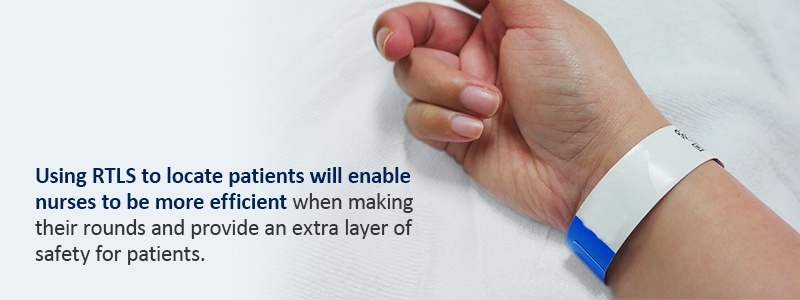
1. Where Is My Patient?
Many hospital campuses are large, with different departments located on different floors. A patient may be taken to another location for x-rays or for diagnostic testing and without RTLS, their nurse would have no insight into their schedule or location within the hospital. RTLS solutions offer room-level locating that enables staff to easily pinpoint whether a sensor and therefore patient or asset, is within the confines of a specific room. By giving each patient a wearable, unintrusive sensor, RTLS accurately records and updates their location in real-time.
If the patient happens wander from where they should be, the system instantly records that movement and can send an alert notification to staff. The system provides hospital staff with a reliable and completely accurate record of the patient's location. Using RTLS to locate patients enables nurses to be more efficient when making their rounds and provide an extra layer of protection for patients.
Hospitals can be hectic, and nurses are overworked making it easy for details to get lost in the shuffle. With RTLS, nurses save precious time and no longer have to search for a patient in need. Instead, they can consult the RTLS system records to quickly locate the patient.
2. Where are the Pumps (or Other Medical Equipment)?
A nurse's ability to quickly locate medical equipment can be a matter of life or death, especially within the intensive care unit. To minimize the risk of frantically searching for equipment, RTLS offers precise locating, so nurses can pinpoint the exact location of the needed asset on a detailed floor plan. Regardless of how large the facility is, RTLS sensors track the location data of thousands of tagged assets' in real-time. Furthermore, the RTLS software provides a visual map and provides reports as well as advances analytics for future workflow improvements.
Rapid location, sub-room level locating and condition updates mean nurses have accurate, real-time information on equipment placement, which is especially helpful when multiple patients share a room. The information offered by location data allows nurses to immediately determine where any tagged asset is. and which patient it is associated with.
3. How Can I Streamline My Workflow?
On average, nurses receive about 72 tasks each hour. These responsibilities include searching for assets or support staff, doing paperwork and responding to interruptions, all of which take away from nurses' time to spend with their patientss. However, your hospital can cut down on these inefficiencies by utilizing RTLS stafflocating and nurse call integration.
By automating and consolidating the workflow process, RTLS staff locating and nurse call integration boosts efficiency and reduces wasted time. With this system, nurses receive notification of a patient call placed over their wireless phone by a corridor light over the caller's door. Once the nurse enters the patient's room, their RTLS enabled staff badge time-records their arrival and cancels the call, providing a hands-free way of improving the overall workflow.
4. Should This Patient Be Leaving?
Whether or not a patient should be discharged is crucial knowledge for staff. RTLS data shows vital information, such as who is being discharged, who needs further services and other essential hospital department encounters.
Questions From Patient Access Personnel
Admitting and discharging patients and managing patient flow are fundamental to maintaining an efficient hospital. Given these significant responsibilities, staff must know where patients are and where they need to be at all times. RTLS lessens the burden by answering the following questions.
5. How Long Has This Patient Been Waiting?
A busy hospital continuously moves various patients through X-rays, operating rooms, intensive care, rehabilitation, etc. With constant movement, it is easy to lose track of the patient workflow, causing unnecessary errors or delays. However, RTLS technology can help departments operate more efficiently and enhance throughput management to improve the patient experience and lower wait times.
RTLS informs the hospital staff exactly how much time has passed since a patient received medical attention and how much time remains until they are seen again. In real-time, staff knows whether a patient has been waiting for an extended period and what they can do to streamline the process. RTLS also offers other patient response time solutions, such as displaying a map of the exact location of caregivers on shift. The technology makes it less of a hassle to contact the closest staff member to assist if necessary. RTLS can help to improve staff response times and decrease patient wait times, helping hospitals deliver better treatment and increase their HCSHPS scores.
Questions From Doctors/Physicians
As some of the busiest people in the hospital, doctors often do not have spare time to search for patients, supporting staff or equipment. RTLS can help doctors treat patients more efficiently and with less stress by addressing these common questions.
6. Where Should I Be?
In an emergency, RTLS helps doctors know exactly where they need to be. As a staff assist and duress solution, RTLS allows doctors to know instantly when and where another medical team member needs help, so they can respond as quickly as possible. By giving a precise location of all staff members at any given moment, RTLS locates nurses and patients in need, enabling quick response during a medical emergency.
RTLS can also track the exact amount of time a doctor spends in each patient's room and automatically update patient health records with an EMR/EHR integration. Recording and analyzing how much time a physician spends with a patient from entrance to exit streamlines workflow processes, which allows the doctor to stay on schedule and provide quality care for all patients.
7. Which Rooms Are My Patients In?
Along with knowing where their fellow staff members are, knowing the exact location of their patients is critical. Thanks to precise locating from RTLS, doctors immediately see where a patient is located by viewing their sensor location on a detailed floor plan. Rapid location and condition updates help doctors stay on top of their interactions with patients and the collection of clinical milestones.
Questions From Patients
RTLS significantly enhances the patient experience and improves the quality of care they receive. By answering the following questions, RTLS can help a patient's hospital visit go as smoothly as possible.
8. What Floor and Room Is My Appointment In?
One of the most convenient features of RTLS for patients is wayfinding. While hospital halls usually seem straightforward to staff members, new patients or visitors may find them confusing. Navigating a hospital's sprawling campus can be overwhelming, but wayfinding takes the stress out of hospital visits by providing turn-by-turn directions to a patient's final destination.
Utilizing location data from an RTLS allows a hospitalto provide applications that guide guests to their destinations, complete with an estimated time of arrival. Instead of wandering around the facility and being late to an appointment, patients arrive on time and less stressed. If a patient is late or misses an appointment, it can back up the provider's schedule creating delays and resulting in loss of revenue. RTLS makes visiting the hospital hassle-free and drastically improves a patient's satisfaction with their visit.
9. Where Is the Nearest Restroom?
In addition to pointing patients in the right direction, wayfinding alerts them of nearby amenities. In a hospital, something as simple as finding a restroom may be time-consuming and confusing, but with RTLS, patients can quickly locate the nearest restroom through the Points of Interest (POI) feature. Wayfinding applications allow a user to select a route, such as an ADA-compliant path to the desired location.
10. Is My Baby Safe?
For new parents, the safety of their infant is paramount. RTLS enhances infant protection by attaching a small, comfortable sensor that communicates continuously with the hospital staff to grant location visibility, promote correct mother-infant matching and prevent unauthorized movement. RTLS sensors for infants include umbilical attachment and ankle bands, both of which are discreet and quickly alert staff if there is any tamper detection.
11. What Is the Quickest Way I Can Call a Nurse?
RTLS offers patients peace of mind through nurse call automation. This RTLS health care feature helps gather essential information, speed up emergency response actions and streamline communication between patients and nurses for a quicker patient response time. With an RTLS enables staff badge, a nurse can immediately acknowledge and address a patient call, while the badge automatically records the nurse's arrival and cancels the call to create a more efficient, hands-free workflow. Since the automated nurse call system provides the precise locations of caregivers, staff can easily contact the closest backup if the assigned caregiver is unable to respond.
Questions From Administrators
Hospital administrators have a significant responsibility to manage the facility's overall operations. RTLS can make their jobs a bit easier by providing answers to these questions.
12. How Can We Improve Safety?
RTLS not only allows staff to locate people and assets within a hospital but can monitor entry and exit points throughout a facility as well. Through this feature, RTLS hospitals regulate who has access to specific areas of the building and can keep a detailed record of who has passed through entry and exit points. If a patient or an asset is approaching a restricted area, the system can alert staff members and automatically lock the doors, preventing the patient or asset from gaining access. Utilizing cameras and security staff are still valuable safety measures, but RTLS technology adds an extra layer of protection for both patients and staff members.
If a staff member feels threatened or unsafe, the RTLS-equipped staff badge has a duress/assist button they can press to receive immediate assistance at their exact location. The badge will continue to update the staff member's location in real-time, so if the staff member has moved to another location after the duress button was pressed, backup will still arrive.
13. How Can We Control Infection?
Infection prevention and control is imperative for a health facility. RTLS can alert hospital staff if equipment has not gone through the proper disinfection process prior to being used on another patient.
RTLS systems supply data on patient and asset location and these reports can be tailored to show interaction between them. Interaction reports, or contact tracing, provides a contact history log used to accurately track interactions with other people and facility equipment. Staff members can view who and what an infected individual encountered, and for how long. This allows the facility to ensure proper quarantine protocols are followed and prevent thr further spread of any communicable disease.
Hands are a known vector for transmissible disease, making hand hygiene an important consideration for infection control at all times - but particularly in the midst of a global health crisis like the one facing us today. A healthcare RTLS system can help ensure staff members are following hand washing protocol using sensors mounted to or embedded in dispensers, canisters, pumps and sinks. These sensors communicate with the staff members RTLS badges and automatically document hand hygiene compliance and noncompliance events. The system also has an option to provide staff with a gentle, real-time hand-washing reminder. Electronic monitoring systems are not only the most effective and only passive way to measure hand-hygiene events, but they have been shown to improve compliance rates and decrease the number of HAIs.
14. How Can I Ensure Our Products Are Safe For Patient Consumption?
Environmental and temperature monitoring records the temperature and conditions, such as humidity or differential air pressure, of rooms, and refrigerators/freezers containing vaccines, medications, blood and lab samples to ensure safekeeping and reduce the risk of patient infection. These sensors automatically alert staff if conditions begin to stray from set parameters. This helps facilities prevent product loss and ensure patients receive effective treatments. Environmental monitoring systems also maintain proper air pressure in inpatient rooms and operating rooms. In the case of communicable diseases, such as COVID-19, it is crucial that patients with the illness are kept in a room with negative air pressure. If the air pressure starts to differ, it puts other patients and staff members at risk of contracting the disease, since the respiratory droplets are no longer contained.
15. How Can We Keep Costs Down?
Healthcare facilities go through a staggering amount of equipment, supplies, laundry, trash and more each day. Amid the chaotic environment of everyday hospital activities, it is easy for small, costly medical equipment to get accidentally wrapped up with soiled linens or other trash and thrown away. A standard 300-bed hospital loses an estimated $200,000, on average, in equipment loss each year.
RTLS helps healthcare facilities with loss prevention through its asset tracking solution. Asset tracking provides instant location visibility for any tagged mobile medical equipment. RTLS technology also allows hospitals to automate critical equipment sharing workflows to reduce over-procurement and rentals. In this way, RTLS assists hospitals in conserving their vital resources and maximizing the utilization of medical equipment they have.
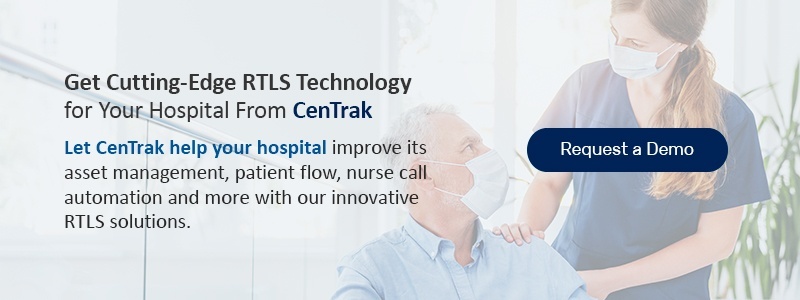
Get Cutting-Edge RTLS Technology for Your Hospital From CenTrak
Currently serving over 1,700 leading health care facilities across the U.S., Europe, Australia, Asia and the Middle East, CenTrak is a superior provider of health care enterprise location services with the latest RTLS technology. Our Clinical-Grade Visibility™ systems operate with more precision than comparable tech, which only provides an estimated location. With accurate visibility, RTLS from CenTrak delivers hospital staff real-time data they can trust.
When it comes to locating equipment and patients in your hospital, there's no room for error. Let CenTrak help your facility improve its asset management, patient flow, nurse call automation and more with our innovative RTLS solutions. Contact CenTrak or request a demo to learn more about how RTLS can enhance your health care services.



